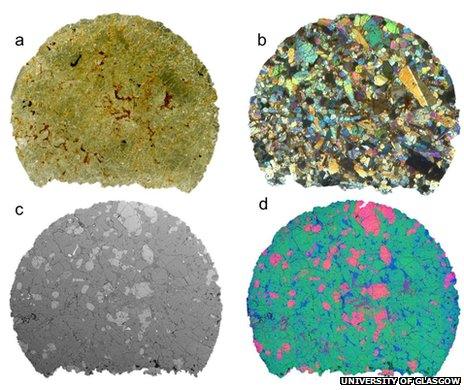Meteorite may explain 'how Mars turned to stone'
- Published

The 4.5cm-wide meteorite could solve the mystery of how Mars lost its atmosphere
A meteorite reveals clues to how Mars lost its thick, carbon dioxide-rich atmosphere and became a cold, rocky desert, researchers say.
They say the Lafayette meteorite shows signs of carbonation - where minerals absorb CO2 in a reaction with water.
Mars lost its protective blanket about 4 billion years ago, perhaps because of the loss of its magnetic field, space impacts, or chemical processes.
Carbonation may be the key factor, they write in Nature Communications, external.
The process occurs naturally on Earth - and has been proposed as a technique for mitigating climate change, by capturing CO2 from the atmosphere.
The 4.5cm Lafayette meteorite was discovered in Indiana, US in 1931, having plummeted to Earth about 3,000 years ago.
It formed in the Red Planet's crust about 1.3 billion years ago, and was ejected from the surface by a massive impact.
A team from the Scottish Universities Environmental Research Centre (SUERC) performed microscopic analysis on a section of the rock - borrowed from the Natural History Museum in London.
A Scotland-based team of researchers study a meteorite from Mars in the hope of learning how we can deal with climate change here on Earth
They found that silicate minerals, such as olivine and feldspar, had interacted with CO2-rich liquid water to form siderite crystals.
The team says their discovery suggests liquid water was present on Mars more recently than some had thought.
They also say it represents the first direct evidence for carbonation on the Red Planet - and ties in with the discovery of carbonates by Nasa's Curiosity Mars rover.
"Carbonation could be the main force that turned Mars to stone," said lead author Dr Tim Tomkinson, of SUERC.
"We can't say for certain it's the dominant cause - the loss of Mars' magnetic field may also have led to the stripping of its atmosphere by the solar wind. And CO2 is also frozen in the poles of Mars.
"But carbonates do seem to be very abundant on the Martian surface."

Microscopic image shows evidence of carbonation with siderite (orange) replacing olivine (blue)
The loss of its carbon dioxide cloak is likely to have caused Mars to cool. So understanding how the CO2 was removed "could provide vital clues to how we can limit the accumulation of carbon dioxide in the Earth's atmosphere and so reduce climate change" said Dr Tomkinson.
Mineral carbonation is widespread on Earth. For example, in Oman's Samail mountains, weathering of peridotite rocks has been estimated to bind more than 10,000 tons of CO2 per year, external.
Speeding up this natural process - by fracking rocks and pumping in purified CO2 - has been proposed as a technique for carbon capture and storage.
"From our analysis of the meteorite, it seems that carbonation occurs in certain orientations - we see amazing saw-tooth edges, all lining up," Dr Tomkinson told BBC News.
"It could be for example that if you wanted to frack rocks and introduce CO2 you should do it from a certain angle."
Dr Caroline Smith, curator of meteorites at the Natural History Museum, said: "These findings show just how valuable meteorites from collections like those we have here really are.
"There is so much important and useful scientific information locked away in these rare rocks.
"Our study shows that as we learn more about our planetary next door neighbour, we are seeing more and more similarities with geological processes on Earth."

Images of a Lafayette meteorite section, highlighting different minerals
- Published19 June 2013
- Published29 August 2013
- Published8 February 2012
- Published19 April 2012